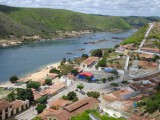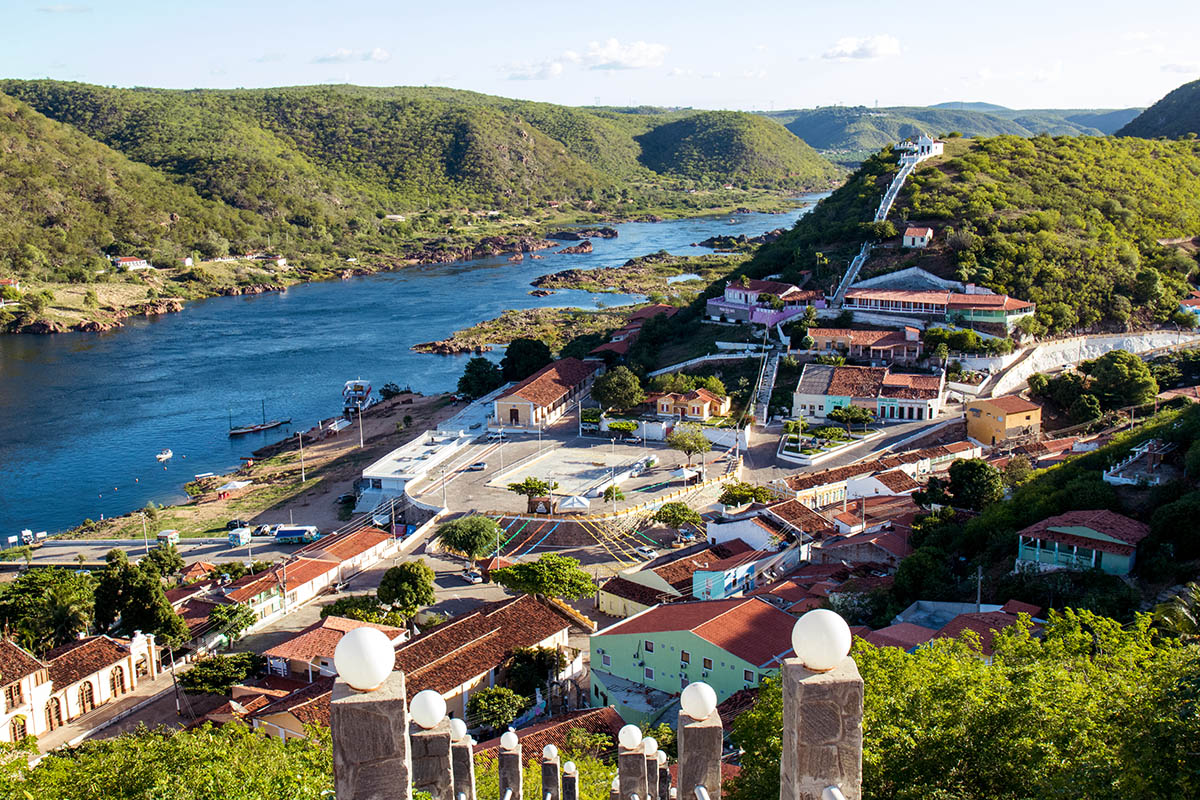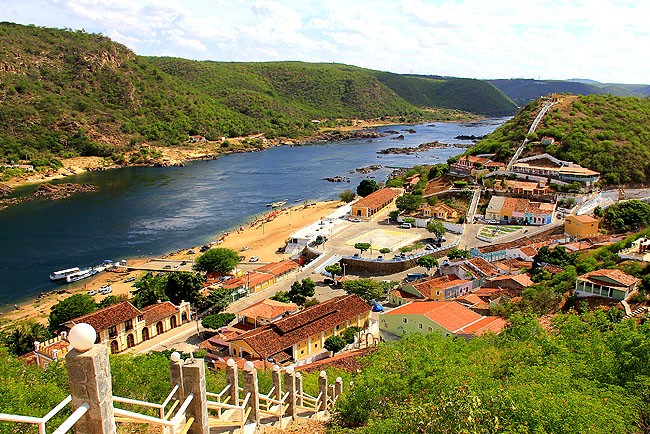Este post também está disponível em:
Português
English

Piranhas is a colonial town bathed by the São Francisco river and pure charm, with its old colourful houses. Dom Pedro II was also charmed by it and spent a good deal of time here – according to the bad language, he was also charmed by a local nobleman.
In addition to the houses and centuries-old gossip, Piranhas has another surprise: it is a must-see for those who want to know more about the cangaҫo.
It is worth noting that the town was never attacked by Lampião, for two good reasons: firstly, because it has only one entrance, which would leave the cangaceiros cornered in case of confrontation; secondly, because the local patron saint, Nossa Senhora, was the devotional saint of the so-called “King of Cangaҫo”.
View the tourist map of Alagoas
Lampião spared Piranhas, but he was not spared: from here one of the troops that intended to capture the cangaceiro and his gang left – and returned with their hands full, with eleven headdresses to be exhibited in the public square. Among them were those of Lampião and Maria Bonita.
The spoils were sent to Bahia, but Piranhas was pleased to be the first place to have exposed the failure of the cangaҫo; here the historic photo was taken, later sold to newspapers throughout the country.
The history of the cangaҫo can be learnt at the interesting Museu do Sertão, one of the attractions of the city, where tourism is still being structured.
Video about Piranhas in Alagoas


Piranhas no interior de Alagoas - Guia de Turismo

Piranhas em Alagoas

Piranhas - Guia de Turismo37:37
Tourist spots of Piranhas AL
1. Cangaço Route and Cangaço Eco Park
Piranhas became nationally known because of the cangaço. Many stories about the band of Virgulino da Silva, Lampião, populate the region.
It was even close to the city, in Grota de Angicos, that the cangaceiros of Lampião’s gang were caught in an ambush and beheaded.
The catamaran trip along the São Francisco River takes about 30 minutes, and the scenery couldn’t be more beautiful.
At the Cangaço Eco Park, tourists are welcomed by a team duly characterised as cangaceiros.
The story of Lampião’s gang is told by one of these characterised guides, who leads the group along a trail to Grota de Angicos.
The trail is about 1.5km long and of medium intensity.
At the end of the trail, we find the site of the ambush where Lampião’s group was surprised and killed by police volantes.
The time of 11am made our walk along the trail a little difficult, with the sun blazing in the sertão. The terrain is dry and sandy, with lots of thorny vegetation and little shade.
Those who prefer, do not do the trail and stay enjoying the Eco Park, with river bath, many hammocks and sun loungers.
2. Historical Centre of Piranhas
It is not for nothing that the Historic Centre of Piranhas was declared a National Historic Site. The architecture of the city is charming.
The city is full of old houses and mansions, all very colourful. And to make it even more beautiful, it has the banks of the Velho Chico framing the city.
At night, the city’s bars, such as the classic Pizzaria e Cachaçaria Altemar Dutra (named in honour of the singer who also walked there), are busy.
And it feels like, as the song said, that good old ‘festa do interior’. It seemed that the whole city was there, in the Praça do Centro Histórico, chatting, listening to forró and drinking a beer.
The party takes place right in the centre, under two cosy trees, with the tables arranged on the street, in an imaginary division of which table is being served by which restaurant. A very delicious atmosphere!
During the day, you can take advantage of the centre to walk around, getting to know the old churches of the city.
In the centre there are two, the Nossa Senhora da Saúde Church, built in the 19th century in neoclassical style, and the Santo Antônio de Lisboa Church, the oldest in Piranhas (1790), where the remains of the city’s founders are deposited.
Other attractions: visit the Xingó Centre for Crafts, Arts and Culture, which is housed in the old Railway Network Machine House; take a dip in the river at the Orla Altemar Dutra beach (him again!).
3. Museu do Sertão Marília Rodrigues
The building of the former municipal railway station in Piranhas, with its neoclassical architecture, has housed this museum since 1983.
One of the rooms displays material related to the navigation of the São Francisco River, the popular culture of the Northeast and the history of the railway that passes through Piranhas.
In the second room, visitors can see some púpitos, oratories and other religious pieces. In the third room, visitors have access to a large collection of items dedicated to the cangaҫo – from photos and objects that belonged to Lampião and his gang to posters from the 1930s offering rewards to anyone who captured the dreaded gang, dead or alive. Former building of the Piranhas Railway Station.
The Museu do Sertão is a great opportunity to learn more about the history of the city, the cangaço and the man from the sertanejo.
The museum has beautiful pieces of riding, of the sertanejo houses, religious, fishing and many photos. Including pieces that refer to the passage of D. Pedro II through the region.
4. Clock Tower
It is right in front of the Sertão Museum. The tower was built in 1879 and its architecture stands out in the centre of Piranhas.
The place houses the ‘Café da Torre’, which operates at the top of the building.
5. Viewpoints
Speaking of beautiful views from the top: Piranhas has a beautiful relief, which gifted the city with two beautiful viewpoints.
The Mirante da Igreja is at the top of 250 steps of a steep and irregular staircase.
At the top is the church of Nosso Senhor do Bonfim, and the view is worth all the effort!
The Mirante Secular is on the opposite side of the Mirante da Igreja and houses an obelisk that was built in the late 19th century to welcome the 20th century, which was beginning.
6. Village of Entremontes
Entremontes is a district of Piranhas. It also has historical importance for having sheltered Dom Pedro II during his trip through the region.
In addition, Entremontes has, like Piranhas, the charm of historic mansions.
A differential is the handicraft of the women lace makers, who make beautiful embroidery of redendê and cross-stitch.
The art of Entremontes is well recognised in the region and even by international designers.
7. Xingó Power Plant
The Xingó Hydroelectric Power Plant is on the road between Piranhas and Canindé de São Francisco. The guided tour takes about 50 minutes.
The tour begins with an explanatory video about the construction of the plant, then we visit the wooden model, carved in incredible detail, a true work of art!
Finally, we are taken to the Plant itself, and we take the tour of the external and internal part. The view from the top of the dam is breathtaking.
There was no gate open when we visited, but you can imagine the force of the water! A monumental work of engineering!
8. Canyons of the São Francisco River
The tour through the Xingó Canyons is what brought us here in the first place. This tour offers you some of the most beautiful landscapes in the region.
You will sail through São Francisco, the River of National Integration, in a way you never imagined. There is a post detailing everything about this tour!
Tourism and Travel Guide to Piranhas, Alagoas and Northeast Brazil



















